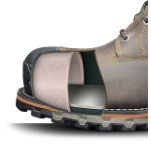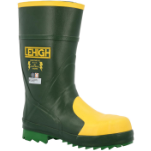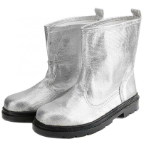Subsection 1.3.6 Foot Protection
Your feet are vulnerable to many potential hazards aboard ship. For example, slips and falls due to wet and slippery decks; heavy objects falling on or rolling over your foot because of the ship’s motion or accident; punctures caused by stepping on sharp objects; and potential electrical shock when your body is grounded through the soles of your shoes. In other industries, there are other hazards to consider, chemical exposure, high temperatures, molten metal splashes, static electricity, to name a few. Proper selection of footwear can minimize the danger of these hazards.
OSHA has established regulations for safety shoe design, including impact and compression strength requirements, and they have mandated footwear requirements for many industries. For example, safety shoes or boots with impact protection are required to be worn in work areas where carrying or handling materials such as packages, objects, parts or heavy tools, which could be dropped; and for other activities where objects might fall onto the feet. Safety shoes or boots with compression protection are required for work activities involving skid trucks (manual materials handling cars) or other activities in which materials or equipment could potentially roll over an employee’s feet. Safety shoes or boots with puncture protection are required where sharp objects such as nails, wire, tacks, screws, large staples, scrap metal etc., could be stepped on by employees causing a foot injury. Although there are no specific OSHA requirements for safety footwear for marine engineers, it is nonetheless sensible to select and wear safety shoes based on the hazards found in the engine room.



Safety Shoes and Boots. Safety shoes and boots are available in many styles depending on the job requirements. Boots provide more protection than shoes from chemicals and molten metals splashes and spark hazards, but they are heavier. Some protective features that are available in both boots and shoes include:
- Oil resistant shoes
- Chemical resistant shoes
- Heat resistant shoes
- Slip and skid resistant shoes
- Waterproof and water resistant shoes
Steel-Reinforced Safety Shoes and Boots Similar to safety shoes, these have the toe box and insole reinforced with steel, and the instep reinforced with steel, aluminum, or plastic. These shoes will protect your feet from falling objects and puncture injuries.
Composite-Toe Safety Shoes Composite-toe shoes have a protective cap made of non-metallic materials such as carbon fiber, Kevlar, or fiberglass. They offer lightweight protection and are ideal for environments where metal detection is required or in situations where electrical conductivity needs to be minimized.
Electrically Insulated Safety Shoes These shoes have non-conductive soles to prevent the wearer’s feet from completing an electrical circuit to ground. They can protect workers against as much as 600 volts in dry conditions. These shoes should be used in conjunction with insulated tools and precautions to reduce or eliminate the potential for providing a path for hazardous electrical energy. Non-conductive footwear must not be used in explosive or hazardous locations; in such locations, electrically conductive shoes are required.
Electrically Conductive Safety Shoes These shoes protect against the buildup of static electricity. Essentially, these shoes ground the employees wearing them. Employees working in explosive and hazardous locations such as explosives manufacturing facilities or grain elevators must wear conductive shoes to reduce the risk of static electricity buildup on an employee’s body that could produce a spark and cause an explosion or fire. During training, employees must be instructed not to use foot powder or wear socks made of silk, wool, or nylon with conductive shoes. Foot powder insulates and retards the conductive ability of the shoes. Silk, wool, and nylon produce static electricity. Conductive shoes are not general-purpose shoes and must be removed upon completion of the tasks for which they are required. Employees exposed to electrical hazards must never wear conductive shoes.

